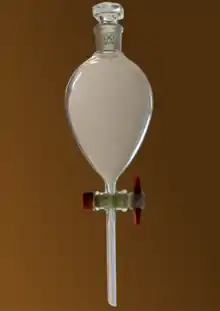Separatory funnel
A separatory funnel, also known as a separation funnel, separating funnel, or colloquially sep Funnel and fractionating Funnel. , is a piece of laboratory glassware used in liquid-liquid extractions to separate (partition) the components of a mixture into two immiscible solvent phases of different densities.[1] Typically, one of the phases will be aqueous, and the other a lipophilic organic solvent such as ether, MTBE, dichloromethane, chloroform, or ethyl acetate. All of these solvents form a clear delineation between the two liquids.[2] The more dense liquid, typically the aqueous phase unless the organic phase is halogenated, sinks and can be drained out through a valve away from the less dense liquid, which remains in the separatory funnel.[3]


Description
A separating funnel takes the shape of a cone with a hemispherical end. It has a stopper at the top and stopcock (tap), at the bottom. Separating funnels used in laboratories are typically made from borosilicate glass and their stopcocks are made from glass or PTFE. Typical sizes are between 30 mL and 3 L. In industrial chemistry they can be much larger and for much larger volumes centrifuges are used. The sloping sides are designed to facilitate the identification of the layers. The stopcock-controlled outlet is designed to drain the liquid out of the funnel. On top of the funnel there is a standard taper joint which fits with a ground glass or Teflon stopper.[4]
To use a separatory funnel, the two phases and the mixture to be separated in solution are added through the top with the stopcock at the bottom closed. The funnel is then closed and shaken gently by inverting the funnel multiple times; if the two solutions are mixed together too vigorously emulsions will form. The funnel is then inverted and the tap carefully opened to release excess vapor pressure. The separating funnel is set aside to allow for the complete separation of the phases. The top and the bottom tap are then opened and the lower phase is released by gravitation. The top must be opened while releasing the lower phase to allow pressure equalization between the inside of the funnel and the atmosphere. When the bottom layer has been removed, the stopcock is closed and the upper layer is poured out through the top into another container.
Theory
The separatory funnel relies on the concept of "like dissolves like", which describes the ability of polar solvents to dissolve polar solutes and non-polar solvents to dissolve non-polar solutes. When the separatory funnel is agitated, each solute migrates to the solvent (also referred to as "phase") in which it is more soluble.
The solvents normally do not form a unified solution together because they are immiscible. When the funnel is kept stationary after agitation, the liquids form distinct physical layers - lower density liquids will stay above higher density liquids. A mixture of solutes is thus separated into two physically separate solutions, each enriched in different solutes.
The valve may be opened after the two phases separate to allow the bottom layer to escape the separator funnel. The top layer may be retained in the separatory funnel for further extractions with additional batches of solvent or drained out into a separate vessel for other uses. If it is desired to retain the bottom layer in the separatory funnel for further extractions, both layers are taken out separately, and then the former bottom layer is returned to the separatory funnel.
Each independent solution can then be extracted again with additional batches of solvent, used for other physical or chemical processes. If the goal was to separate a soluble material from mixture, the solution containing that desired product can sometimes simply be evaporated to leave behind the purified solute. For this reason, it is a practical benefit to use volatile solvents for extracting the desired material from the mixture.[5]
Emulsions
One of the drawbacks of using a separatory funnel is emulsions can form easily, and can take a long time to separate once formed. They are often formed while liquids are being mixed in the separatory funnel. This can occur when small droplets are suspended in an aqueous solution. If an emulsion is formed, one technique used to separate the liquids is to slowly swirl the solution in the separatory funnel. If the emulsion is not separated by this process, a small amount of saturated saline solution is added ("salting out").[6]
Research is being done on alternative, more efficient techniques, mostly utilizing stir bars to decrease or even eliminate the chance of emulsification, thus decreasing the amount of waiting time.[7]
Safety concerns
The largest risk when using a separatory funnel is that of pressure build-up. Pressure accumulates during mixing if a gas evolving reaction or physical change occurs. This problem can be easily handled by simply opening the stopper at the top of the funnel routinely while mixing. More standard procedure is to invert the separatory funnel upside down, and open the tap to release the pressure. This should be done with the tip of the funnel pointed away from the body.[8]
Gallery

- Upper phase
- Lower phase
 The ether layer with a dissolved yellow compound is on top and an aqueous layer is at the bottom
The ether layer with a dissolved yellow compound is on top and an aqueous layer is at the bottom.1_-_07_(Large).JPG.webp)
See also
- Decantation is a process of pouring off the top layer of liquid from a bottom layer of liquid or solid
- Decanter centrifuge
- Dropping funnels are similar in shape and design, and may be used as separatory funnels. They have standard taper ground glass joints at the stem.
- Partition coefficient is a measure of the distribution of an analyte between the two phases in a separation.
References
- "Archived copy". Archived from the original on 2010-12-09. Retrieved 2016-12-12.CS1 maint: archived copy as title (link)
- "Archived copy" (PDF). Archived from the original (PDF) on 2012-04-25. Retrieved 2011-11-17.CS1 maint: archived copy as title (link)
- Padìas, Anne B. (2011). Making the Connections2: A How-To Guide for Organic Chemistry Lab Techniques.Plymouth, Michigan: Hayden-McNeil Publishing, p. 129.
- "Chemistry and Biochemistry". 2018-09-06.
- "Recrystallization Technique - [www.rhodium.ws]".
- "Archived copy". Archived from the original on 2012-03-14. Retrieved 2016-12-12.CS1 maint: archived copy as title (link)
- Bye, Ragnar; Agasöster, Tone; Åsheim, Arne (1993). "A novel and fast extraction technique as an alternative to conventional separatory funnels". Fresenius' Journal of Analytical Chemistry. 345 (6): 411–414. doi:10.1007/BF00325616. S2CID 97042736.
- Fessenden, J., Joan S. Fessenden, Patty Feist. Organic Laboratory Techniques, 3rd Edition, 2001. Pacific Grove, California: Brooks Cole Publishing, p. 59.
